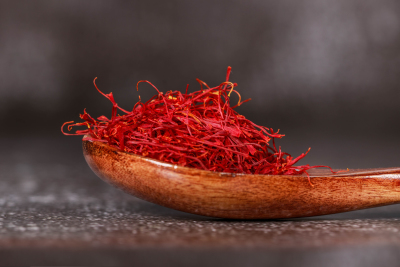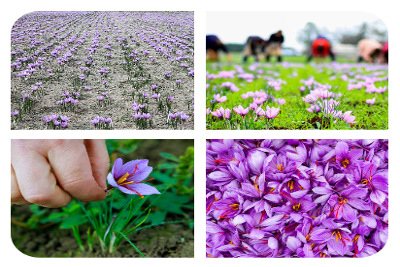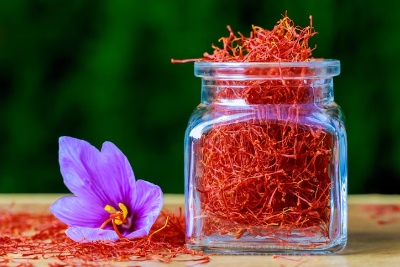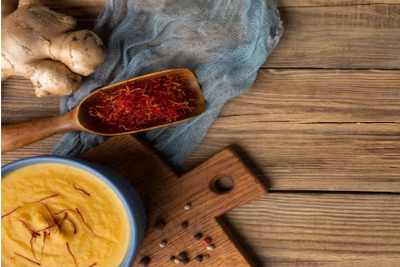
The Golden Spice: Saffron The most expensive spice of the world.
Saffron, the world's most expensive spice, is known for its beautiful golden hue and delicate floral aroma. It is derived from the delicate red threads of the Crocus sativus flower, which must be hand-picked and carefully dried to preserve their flavor and aroma. Saffron has been used in cuisine, medicine, and even religion for thousands of years, and its distinctive flavor and color make it a favorite ingredient in dishes all over the world.
History and Origins of Saffron
The origins of saffron are shrouded in mystery and myth, but it is believed to have been first cultivated in ancient Persia, now modern-day Iran, over 3,500 years ago. The spice was highly prized by the Persians, who used it in cooking, perfumes, and medicines. Saffron spread throughout the Mediterranean region and beyond, and was traded along the Silk Road, which connected Asia and Europe.

During the Middle Ages, saffron became a symbol of luxury and wealth, and was highly valued by European nobility. It was used to dye cloth and textiles, as well as for medicinal purposes. Today, saffron is still grown and harvested in Iran, as well as other countries including Spain, Greece, India, and Morocco.
Cultivation and Harvesting of Saffron
The best saffron is grown in Iran, where the climate and soil conditions are ideal for cultivation. Saffron cultivation is a labor-intensive process, and the delicate flowers must be carefully tended to in order to produce high-quality threads. The flowers are typically planted in the late summer or early fall, and are harvested in the autumn, when the flowers have fully bloomed. Each flower contains only three red stigmas, which must be hand-picked by skilled workers.
Once the stigmas have been harvested, they are carefully dried to preserve their flavor and aroma. This process can take several days, and must be done in a warm, dry environment. The dried stigmas are then packaged and sold as saffron, ready to be used in cooking or other applications.

Culinary Uses of Saffron
Saffron is an incredibly versatile spice, and is used in dishes all over the world. In Indian cuisine, saffron is often used to flavor rice dishes like biryani, as well as in desserts like kulfi and ras malai. In Spanish cuisine, saffron is a key ingredient in paella, a rice dish flavored with saffron and a variety of other spices and ingredients. In Iranian cuisine, saffron is used to flavor a variety of dishes, including stews, rice dishes, and desserts like saffron ice cream. Saffron is also used in Moroccan cuisine, where it is used to flavor tagines and couscous dishes. Saffron's delicate flavor and aroma make it a popular ingredient in gourmet cuisine. It adds a distinct taste and color to dishes, making them more visually appealing.
Health Benefits of Saffron
Despite its culinary uses, saffron has also been used for medicinal purposes for thousands of years. Saffron contains a variety of compounds that are believed to have antioxidant and anti-inflammatory properties, and may be helpful in treating a variety of conditions.
Saffron has been shown to have a positive effect on brain function. Studies have found that it may improve memory and cognitive function, making it a promising natural remedy for neurodegenerative diseases such as Alzheimer's. Some studies have suggested that saffron may be effective in treating depression and anxiety, and may be helpful in managing symptoms of premenstrual syndrome (PMS) and menopause. Additionally, saffron has been shown to have potential anticancer properties, and may be helpful in preventing and treating certain types of cancer.

Saffron in Art and Literature: A Cultural Exploration of Its Symbolism and Representation
Saffron, has inspired artists and writers throughout history. Saffron vibrant color which is a deep, rich shade of orange-red, have been used to represent wealth, prestige, and beauty. In Indian art, saffron is associated with divinity and enlightenment, while in Persian art, it symbolizes love and sensuality. In literature, saffron has been used to symbolize healing, deceit, and exoticism. Saffron's unique color and aroma have inspired creativity in different forms of art, from textiles and culinary arts to music and film. Overall, saffron remains a powerful symbol of human creativity and imagination in art and literature.
Saffron is a unique and valuable spice that has been prized for centuries for its flavor, color, and medicinal properties. It is cultivated in different parts of the world and used in many traditional dishes. Although it is expensive, saffron is a valuable addition to any kitchen due to its distinctive flavor and health benefits. Whether you are a chef or a health enthusiast, exploring the world of saffron is an exciting and rewarding experience.
Islamic Services of America (ISA) is a leading USA based Halal certification and auditing organization serving companies, the community, and the Halal industry for over 45 years. Contact ISA at isa@isahalal.com or visit the ISA website for more information at https://www.isahalal.com/
